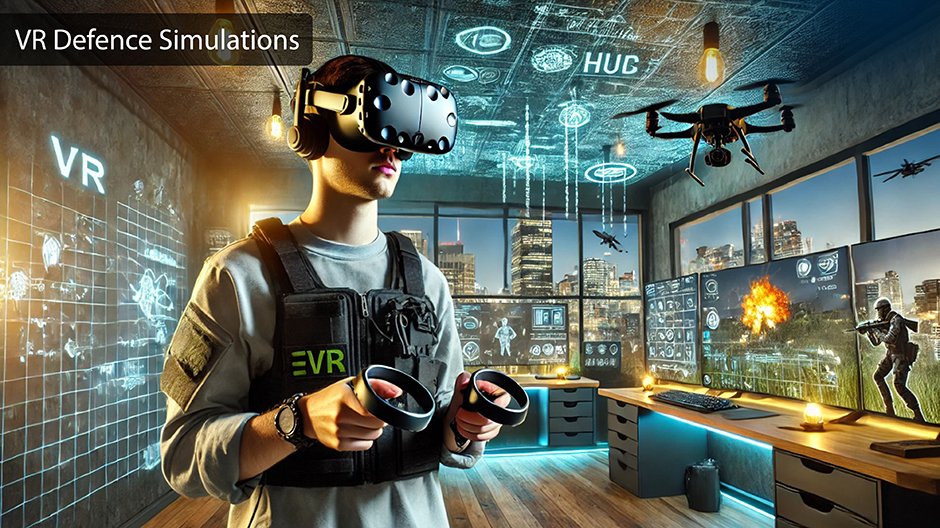Skip to the good bit
ToggleVR’s Role in Training on the Rise
The present military training revolution has been overtaken by virtual reality (VR) technology, which diverts personnel from truly educating them for strategic missions and war. The usage of this technology for training, which creates realistic combat settings to improve skill and decision-making, has increased dramatically in the previous several years. Virtual reality (VR) is becoming a vital tool for defense readiness globally as creative, entry-audit military organizations.
Transforming Military Training through Immersive Simulations
Heavy physical endurance exercises are typically a part of traditional military training methods like war games, live-fire exercises, and military drills. However, these approaches are time-consuming, expensive, and even risky. Virtual reality is a groundbreaking tool in military training that allows soldiers to train in realistic, safe, and interactive surroundings without suffering any physical harm.
By means of virtual reality, the trainees are transported to incredibly detailed battlefields that replicate authentic combat settings. To enable some of the best imitative training, the replication could incorporate a variety of meteorological condition factors, topographical obstacles, and even enemy engagements. VR headsets and motion-tracking technologies allow soldiers to immerse themselves in a virtual world that depicts movement over terrain, AI-powered fighting, and tactical moves in a strictly regulated pattern.
Cost-Effective and Scalable Training Solutions
VR’s cost-effectiveness is by far its greatest benefit when it comes to defense training. Because they require a lot of physical resources, ammunition, and logistics, physical training exercises are costly and resource-intensive. Most of these expenses are eliminated with VR since training is so simple and requires no physical exertion.
Furthermore, the training can be easily scaled up, enabling a group of trainees from several training facilities to participate simultaneously. It is particularly helpful in large military groups where geographical restrictions prevent people from receiving simultaneous training. Here, soldiers stationed in various bases or even nations can take part in the same training exercise thanks to cloud-delivered virtual reality.
Enhancing Tactical and Strategic Decision-Making
Conditions unique to combat frequently dictate how quickly and accurately weapons and equipment must be used. Military personnel can exercise rapid thinking and flexibility by handling high-pressure, real-life circumstances through the use of cutting-edge VR-based training scenarios. As an illustration, soldiers are given scenarios that simulate hostage rescue, counterterrorism operations, or even urban combat, all of which test their capacity to react to unforeseen dangers.
Additionally, commanders and strategists can utilize virtual reality (VR) to test different operational plans in virtual reality before putting them into action, monitor enemy locations, and assess combat conditions. Such comprehensive strategic preparation can greatly increase mission success and lower casualties.
Specialized Training for Different Defence Sectors
It covers defense training for the air force, navy, marines, and special operations units in addition to the ground forces. Here’s an example.
- Aviation Training:More realistic simulations of air combat, emergency landings, aerial battles, and successful counterparts can also be presented to pilots. By simulating situations within various aircraft cockpits, modern, sophisticated virtual reality systems allow pilots to become acquainted with the controls and procedures before embarking on any mission.
- Training in the Navy:It gets the sailor and navy officer ready for experience in submarine operations, ship navigation, and maritime combat scenarios. It also takes into account the previously described preparation by utilizing a variety of emergency situations, such as fire outbreaks, ship evacuations, and underwater rescues.
- Special Forces Training: To practice missions, hostage rescues, or urban warfare situations, commandos and counterterrorism forces can utilize virtual reality technology. High-fidelity, reality-based mission environments like this promote efficiency and mission preparedness.
VR for Medical and Psychological Preparedness
Virtual reality, or VR, is being used in military medical training in addition to combat training. Medics and field physicians might practice emergency surgery, trauma response, and first aid on-site by using virtual simulations. Medical professionals can better prepare for high-stress situations when treating actual patients by using such scenarios.
Additionally, the soldiers’ general mental health is greatly impacted by this virtual reality component. A soldier will experience PTSD and other psychological issues as a result of being exposed to wartime stress. Effective therapeutic programs are being created for the soldiers, which will enable them to use simulation and exposure therapy techniques to experience the trauma.
Integration of AI and Haptic Technology in VR Training
In fact, when haptic feedback and artificial intelligence are added to VR training, the entire field’s future looks much brighter. Artificial intelligence (AI)-enabled virtual adversaries behave like real people, pick up on the trainees’ behavior, and further modify the training settings to make them more dynamic and unpredictable. As a result, soldiers must constantly improve their strategies to stay competitive.
In the near future, haptic technology will enhance VR’s ability to train users for actual combat by creating realistic-feeling virtual environment interactions. Trainees will be able to experience gun recoil, explosions, and the weight of gears being loaded in switching scenarios with the help of such haptic suits and gloves.
Global Adoption and Future Prospects
Virtual reality has become a standard component in the majority of defense organizations worldwide. It made investments in VR-based military training systems in nations like China, the United States, the United Kingdom, and India. The top tech firms and allied defense contractors collaborate to develop the most cutting-edge virtual reality systems designed especially for defense applications.
Conclusion
Military readiness has advanced as a result of the use of virtual reality in defense training. The way that soldiers, pilots, naval officers, and medical professionals practice their participation in various conflict and crisis scenarios will be drastically changed by immersive, reasonably priced, and scalable training. Military training seems to have a bright future as long as international defense agencies keep absorbing and improving the technology. As a result, the military will be better equipped than ever to handle the difficulties of contemporary conflict.







